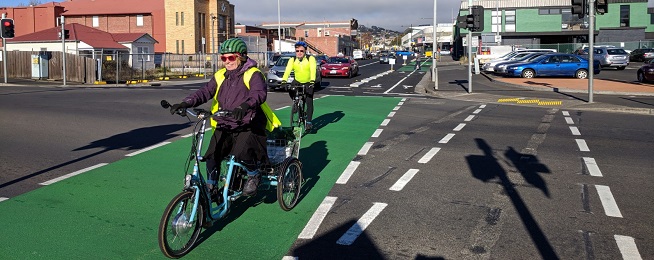This week in Hobart, local and state government engineers and planners, transport researchers and public health advocates are getting together to talk about how Tasmania could adopt separated cycleways.
Cycleways that separate people riding from people driving cars are being built in cities across the globe to strengthen road safety, reduce traffic congestion, and improve public health.
In cities where networks of separated cycleways are built, more people ride as a way to get to work, study, shopping, services and entertainment.
For separated cyleways to be successful the 8–80 principle comes into play. The cycleways must be built in a way that you’d be happy for your 8-year old son or your 80-year-old grandmother to ride them.
While networks of painted lanes give more certainty to drivers and riders about where they should be on the road, they don’t stop cars hitting people.
Tasmanians are generally respectful of bicycle riders but drivers distracted by mobile phones are an increasing risk for other road users.
Bicycle Network has called for governments to explore technology that blocks data getting to drivers’ phones and the NSW government is already trialling technology that can photograph drivers who use phones and issue fines.
But even if such technology is implemented, there is always the risk that when bicycles and cars mix in the same road space that the bicycle rider will be the worse off in a crash.
Cycleways that are physically barricaded from traffic provide that extra bit of protection that makes more people feel more comfortable about riding.
And the more people there are riding, the safer it becomes to ride as drivers get used to seeing and looking for bicycles.
After Seville in Spain introduced a network of separated cycleways, the number of bicycle trips increased from about 3 million to 16 million and the number of crashes with cars decreased from about 15 per million bicycle trips to six.
At this week’s Bike Futures seminar, the head of Sydney’s cycling strategy will talk about how the city has doubled rider numbers in the past six years, including 12.5km of separated cycleways.
Riding a bicycle for transport has become such a viable option that Infrastructure Australia recently prioritised a project to increase Sydney’s dedicated cycling paths to 284km.
Hobart is the ideal place for this seminar as there are several projects underway that will increase the number of people wanting to safely move around and through the city centre.
The university is expanding its footprint with more than 1,000 student beds and new campuses, several large hotels are being planned and constructed, and apartment complexes in and near the city are being built or planned.
While the Intercity Cycleway and Hobart Rivulet path already deliver hundreds of riders to the edge of the city, more people may ride if the paths joined to on-road separated lanes that got them to their final destinations.
Building separated cycleways will involve some sacrifices of parking bays and turning lanes, but increasing space on the road to move more people safely is worth it.
Roads are expensive to build and maintain so it makes sense to use that space as efficiently as we can to move the maximum numbers of people quickly. That means some roads should have more space for public transport, riding and walking.
Separated cyleways, combined with an electric share bike scheme, could transform the way Hobartians get around their city, and improve their health while they’re at it.
This article was printed in The Mercury on Saturday 30 June, 2018


